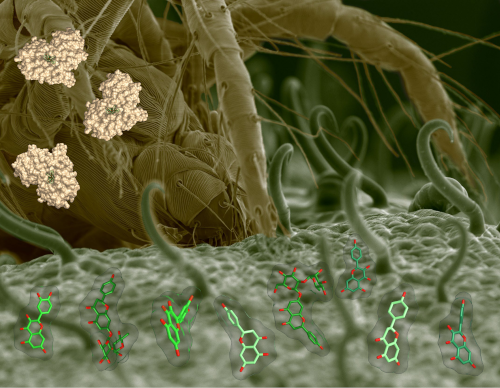2023
156. Hwang J., Barman S., Gao R., Yang X., O’Malley A., Nagarkatti P., Nagarkatti M., Chruszcz M., Tang C. (2023) “Membrane-Active Metallopolymers: Repurposing and Rehabilitating Antibiotics to Gram-Negative Superbugs.” Advanced Healthcare Materials 12, 2301764. DOI: 10.1002/adhm.202370203
155. Arriaza R.H., Abiskaroon B., Patel M., Daneshian L., Kluza A., Snoeck S., Watkins M.B., Hopkins J.B., Van Leeuwen T., Grbic M., Grbic V., Borowski T., Chruszcz M. (2023) “Structural and functional studies reveal the molecular basis of substrate promiscuity of a glycosyltransferase originating from a major agricultural pest.” Journal of Biological Chemistry 299, 105421. DOI: 10.1016/j.jbc.2023.105421

154. Andrys-Olek J., Selvanesan B.C., Varghese S., Arriaza R.H., Tiwari P.B., Chruszcz M., Borowski T., Upadhyau G. (2023) “Experimental and Computational Studies Reveal Novel Interaction of Lymphocytes Antigen 6K to TGF-β Receptor Complex.” International Journal of Molecular Sciences 24, 12779. DOI: 10.3390/ijms241612779
153. Khatri K., O’Malley A., Linn C., Kowal K., Chruszcz M. (2023) “Role of Small Molecule Ligands in IgE-Mediated Allergy.” Current Allergy and Asthma Reports 23(9):497-508. DOI: 10.1007/s11882-023-01100-2

152. Dramburg et al. (2023) “EAACI Molecular Allergology User’s Guide 2.0” Pediatric Allergy and Immunology 34, e13854. DOI: 10.1111/pai.13854

151. Terán M.G., García-Ramírez B., Mares-Mejía I., Ortega E., O’Malley A., Chruszcz M., Rodríguez-Romero A. (2023) “Molecular Basis of Plant Profilins’ Cross-Reactivity.” Biomolecules 13, 608. DOI: 10.3390/biom13040608
150. Kader S., Arriaza R.H., Khatri K., O’Malley A., Grbic V., Grbic M., Chruszcz M. (2023) “Current status of structural studies of proteins originating from Arachnida.” Systematic & Applied Acarology 28, 298-308. DOI: 10.11158/saa.28.2.12

agricultural and material sciences, but are significantly understudied.
149. Selvanesan B.C., Varghese S., Andrys-Olek J., Arriaza R.H., Prakash R., Tiwari P.B., Hupalo D., Gusev Y., Patel M.N., Contente S., Sanda M., Uren A., Wilkerson M.D., Dalgard C.L., Shimizu L.S., Chruszcz M., Borowski T., Upadhyay G. (2023) “Lymphocyte antigen 6K signaling to aurora kinase promotes advancement of the cell cycle and the growth of cancer cells, which is inhibited by LY6K-NSC243928 interaction.” Cancer Letters 558, 216094. DOI: 10.1016/j.canlet.2023.216094
148. Smith S.A., Chruszcz M., Chapman M.D., Pomés A. (2023) “Human Monoclonal IgE Antibodies-a Major Milestone in Allergy.” Current Allergy and Asthma Reports 23, 53-65. DOI: 10.1007/s11882-022-01055-w

147. Prakash R., Goodlett D.W., Varghese S., Andrys J., Gbadamosi F.A., Arriaza R.H., Patel M., Purushottam B.T., Borowski T., Chruszcz M., Shimizu L.S., Upadhyay G. (2023) “Development of fluorophore labeled or biotinylated anticancer small molecule NSC243928.” Bioorganic and Medicinal Chemistry 79, 117171. DOI: 10.1016/j.bmc.2023.117171
